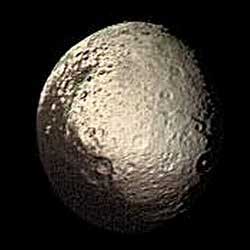.
In Greek mythology Iapetus, or Iapetos (eye-ap'-i-tus, Greek Ιαπετός), was a Titan, the son of Uranus and Gaia, and father (by an Oceanid named Clymene or Asia) of Atlas, Prometheus, Epimetheus, and Menoetius and through Prometheus and Epimetheus and Atlas an ancestor of the human race.
Iapetus is the one Titan mentioned by Homer in the Iliad (8.478–81) as being in Tartarus with Cronus.
Iapetus' wife is normally a daughter of Oceanus and Tethys named Clymene or Asia.
But in Aeschylus's play Prometheus Bound, Prometheus is son of the goddess Themis with no father named (but still with at least Atlas as a brother).
Since mostly the Titans indulge in marriage of brother and sister, it might be that Aeschylus is using an old tradition in which Themis is Iapetus' wife but that the Hesiodic tradition preferred that Themis and Mnemosyne be consorts of Zeus alone. But it would be been quite within Achaean practice for Zeus to have taken the wives of the Titans as his mistresses after throwing down their husbands.
Pausanias (8.27.15) writes:
As I have already related, the boundary between Megalopolis and Heraea is at the source of the river Buphagus. The river got its name, they say, from a hero called Buphagus, the son of Iapetus and Thornax. This is what they call her in Laconia also. They also say that Artemis shot Buphagus on Mount Pholoe because he attempted an unholy sin against her godhead.
Buphagus is a tributary of the river Alpheus, Thornax is a mountain between Sparta and Sellasia, and Pholoe is a mountain between Arcadia and Elis.
Stephanus of Byzantium quotes Athenodorus of Tarsus:
Anchiale, daughter of Iapetus, founded Anchiale (a city near Tarsus): her son was Cydnus, who gave his name to the river at Tarsus: the son of Cydnus was Parthenius, from whom the city was called Parthenia: afterwards the name was changed to Tarsus.
This may be the same Anchiale who appears in the Argonautica (1.1120f):
And near it they heaped an altar of small stones, and wreathed their brows with oak leaves and paid heed to sacrifice, invoking the Mother of Dindymum, Most Venerable, Dweller in Phrygia, and Titias and Cyllenus, who alone of many are called dispensers of doom and assessors of the Idaean Mother, – the Idaean Dactyls of Crete, whom once the nymph Anchiale, as she grasped with both hands the land of Oaxus, bare in the Dictaean cave.
Iapetus is sometimes equated with Japheth, the son of Noah, based on the similarity of their names.
| Ancient Greece
Science, Technology , Medicine , Warfare, , Biographies , Life , Cities/Places/Maps , Arts , Literature , Philosophy ,Olympics, Mythology , History , Images Medieval Greece / Byzantine Empire Science, Technology, Arts, , Warfare , Literature, Biographies, Icons, History Modern Greece Cities, Islands, Regions, Fauna/Flora ,Biographies , History , Warfare, Science/Technology, Literature, Music , Arts , Film/Actors , Sport , Fashion --- |
Retrieved from "http://en.wikipedia.org"
All text is available under the terms of the GNU Free Documentation License


